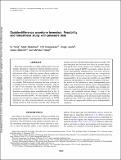Double-difference waveform inversion: Feasibility and robustness study with pressure data
Author(s)
Yang, Di; Meadows, Mark; Inderwiesen, Phil; Landa, Jorge; Fehler, Michael; Malcolm, Alison E.; ... Show more Show less
DownloadYang-2015-Double-difference.pdf (3.136Mb)
PUBLISHER_POLICY
Publisher Policy
Article is made available in accordance with the publisher's policy and may be subject to US copyright law. Please refer to the publisher's site for terms of use.
Terms of use
Metadata
Show full item recordAbstract
Time-lapse seismic data are widely used to monitor reservoir changes. Qualitative comparisons between baseline and monitor data sets or image volumes provide information about fluid and pressure effects within the reservoir during production. However, to perform real quantitative analysis of such reservoir changes, quantitative estimates of the elastic parameters are required as input parameters to rock-physics-based reservoir models. Full-waveform inversion has been proposed as a potential tool for retrieving subsurface properties, such as P- and S-wave velocities and density by fitting simulated waveforms to seismic data. An extension of this method to time-lapse applications seems straightforward, but, in fact, it requires more tailored processes such as double-difference waveform inversion (DDWI). We used realistic 2D synthetic pressure data examples to compare the performance of DDWI with that of two other inversion schemes: one using the same starting model for both inversions and the other starting the monitor inversion with the final baseline inversion model. The data simulation and inversion were based on acoustic theory. Although P-wave velocity changes were reliably recovered by each inversion method, DDWI was found to deliver the best results when perfectly repeated surveys were used. However, differencing the baseline and monitor data sets, as required by DDWI, could be found to be sensitive to the presence of survey nonrepeatability. To investigate the feasibility of using DDWI in practice, the dependence of DDWI on the quality of the baseline models and its robustness to survey nonrepeatability were studied with numerical tests. Various types of nonrepeatability were considered separately in the synthetic tests, including random noise, acquisition geometry mismatch, source wavelet discrepancy, and overburden velocity changes. A study of the correlation between the levels and types of nonrepeatability and the resulting contamination of the inversion results found that, for pressure data, DDWI was capable of inverting reliably for P-wave velocity changes under realistic survey nonrepeatability conditions.
Date issued
2015-09Department
Massachusetts Institute of Technology. Department of Earth, Atmospheric, and Planetary Sciences; Massachusetts Institute of Technology. Earth Resources LaboratoryJournal
GEOPHYSICS
Publisher
Society of Exploration Geophysicists
Citation
Yang, Di, Mark Meadows, Phil Inderwiesen, Jorge Landa, Alison Malcolm, and Michael Fehler. “Double-Difference Waveform Inversion: Feasibility and Robustness Study with Pressure Data.” GEOPHYSICS 80, no. 6 (November 2015): M129–M141. © 2015 Society of Exploration Geophysicists
Version: Final published version
ISSN
0016-8033
1942-2156